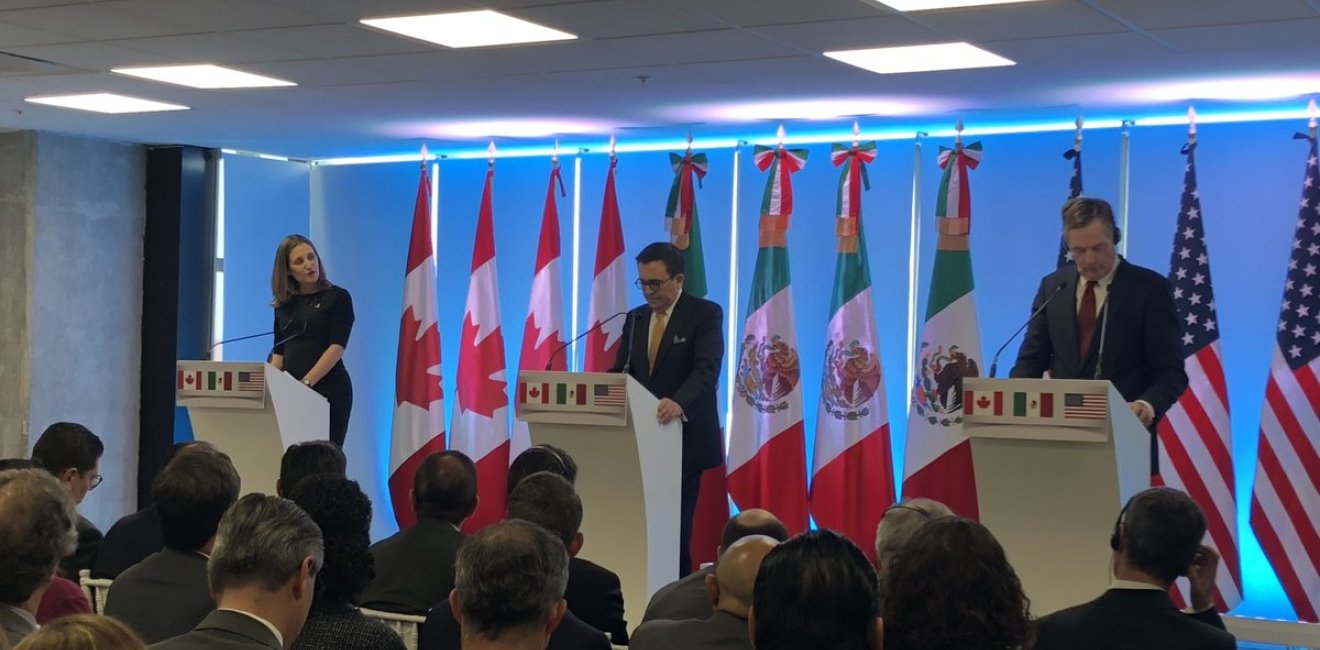NAFTA on More Solid Footing, Despite the Drama
Despite a flurry of drama surrounding the negotiations, the prospects for finishing a successful NAFTA 2.0 are now better than they’ve ever been. But not anytime soon.
Despite a flurry of drama surrounding the negotiations, the prospects for finishing a successful NAFTA 2.0 are now better than they’ve ever been. But not anytime soon.

Despite a flurry of drama surrounding the negotiations, the prospects for finishing a successful NAFTA 2.0 are now better than they’ve ever been. But not anytime soon. The negotiating subjects are complex and lengthy. By my estimate, the negotiators have provisional settlements on about 30-40 percent of the negotiating text (6 or 7 of 28 to 30 chapters), with the difficult elements pushed off to the end stages. Add to this the inevitable delays and diversions caused by the political storms swirling outside.
I predict that NAFTA 1.0 remains in place for the time being because the mechanics of removing it are too complex and this Congress is not inclined to see a deal that is foundational to U.S. agriculture and manufacturers killed on their watch. Meanwhile NAFTA 2.0 will progress in fits and starts, slowed down by all the old irritants and few new ones. Major political disruptors include the U.S. congressional midterms, the Mexican presidential elections, as well as tweets and leaks from all sides. Negotiations for 2.0 are likely to be wound down in the spring/summer and may not resume until 2019, if at all.
Following on a successful tax reform initiative, influencers from the manufacturing, services, and retail sectors are following the trail blazed by agriculture months ago, providing late, but welcome, support for the NAFTA. The White House seems to be taking note of key players. The obvious calculation is that the President does not want to lose the gains he has made through the tax cut due to missteps on trade.
However, finishing the NAFTA 2.0 negotiations and finishing them soon are very different. Big issues like autos, intellectual property, government procurement, labour, and dispute settlement are showing very little movement. Issues of importance to Canada such as supply management and temporary movement of workers across borders are stuck in the starting gates. Issues where there could be some productive give-and-take are stalled by what many in Canada and Mexico perceive as a hostile negotiating environment perpetuated by the U.S. After seven rounds of negotiations, there is tangible progress in three types of issues:
The TPP has served as an accelerant to the current negotiations by providing a template for language and principles in new issues such as digital modernization and currency controls but it offers little assistance to resolve the ‘poison pills’ such as the sunset clause that would kill the deal after four years or 50 percent mandatory U.S. content in North American autos.
Politics continue to play an outsized role in these negotiations. Some elements are distracting, some are worrisome but none are catastrophic. The departure of key economic advisor, Gary Cohn, from the White House has shaken U.S. pro-trade advocates who relied on Cohn to curb the protectionist proposals advanced by Peter Navarro and others. Similarly, the spectre of Section 232 aluminum and steel tariffs, while not a component of the NAFTA, will continue to haunt the negotiations. (It is far too early in the game to say that there will be cross-issue horse-trading to inoculate Canadian steel and aluminum). Meanwhile, the appeal of Section 232 as a weapon will likely be blunted by domestic opposition to what is perceived by many as a tax on U.S. consumers and manufactures. Also mitigating against full implementation of 232 are credible threats of retaliation by the EU and others against U.S. food products and iconic brands.
Another counterweight against the protectionist impulses of the White House is the power of Congress to curb overreach by the executive branch. Individual members of Congress and key trade committees are signaling to the White House that their minimally acceptable conditions for the NAFTA are that it be durable, enforceable, and must contain elements that support U.S. commercial policy such as investor-state dispute settlement. Otherwise, the U.S. negotiators will be sent back to the table.
The President and USTR may propose, but, on trade matters, Congress has the final say. Under a Republic majority, a pro-trade disposition is likely to continue. But, even if the Democrats come back strong in the midterms, this does not necessarily signal a shift away from trade internationalism. Remember, the Trans-Pacific Partnership was an Obama initiative. On foreign commercial engagement, the schism is less between Democrats and Republicans than it is between moderates and the extreme edges of their parties.
Even if Congress cannot prevail against rising protectionism in the U.S., the court system is the last line of defence as business organizations line up to challenge the President’s authority over commercial and trade matters. While these claims may not be successful in the long run, they could delay extreme actions from coming into force for a prolonged period.
Of interest to the energy sector, it looks as though the U.S. might be walking back from their early proposal to do away with the energy chapter altogether. Granted, the 1994 chapter focused mostly only carving out Mexican exceptions that are no longer needed as Mexico privatizes its oil sector, but a standalone energy chapter could still offer a legal and institutional framework for cross-border cooperation in areas of mutual interest. These could include regulatory alignment on pipeline permitting and infrastructure and a mandatory trilateral review mechanism that would flag problems before they become disputes.
Given that updated energy provisions will be relatively new field of endeavor and one that trade negotiators do not typically deal with, energy stakeholders have a unique opportunity to put new suggestions on the table for government negotiators. To this end, Canada Institute hosted a roundtable, convened by Rona Ambrose in Calgary on February 26. We met with senior energy executives to get their input, not only on immediate prospects for the NAFTA but other regulatory areas where improved cross-border cooperation could improve the competitiveness of North American energy in the world.
A more worrisome element for the energy sector and any industry with cross-border operations is the highly politicized dynamics surrounding Investor-State Dispute Settlement (ISDS). For firms invested across borders, the ability to utilize the NAFTA arbitration body can provide greater transparency and reliability than domestic courts in the host country. For several months, the U.S. has been proposing an opt-in/opt-out approach to ISDS, although it wasn’t clear who would do the opting and when.
Reportedly, Mexico and Canada have re-affirmed their commitment to ISDS and advised the Americans that they can stay or go as they wish. Since U.S. companies are quite firmly in favour of keeping their protections abroad (and since they have never lost a NAFTA ISDS case), it is expected that USTR and the White House will be subject to a surge of U.S. businesses demanding to maintain the current regime, or even strengthen it.
On automotive rules of origin, we are not seeing much formal progress in terms of agreed-upon settlements, but the negotiators are holding informal ‘brainstorming’ sessions with stakeholders to develop proposals that may form the basis of a future deal and as an alternative to the proposed 50 percent required U.S. content (and 85 regional) that USTR put on the table. In essence, the three countries are examining to re-balance the equities in the auto sector by putting a greater focus on high-tech and high value-added products and providing incentives to encourage new plants and higher levels of R&D. (Does this sound like an Auto Pact for the new millennium? Watch this space.)
One issue that will be a real sticking point to concluding a deal is labour. A key message during the presidential election is that Mexico’s relatively lower wages in the manufacturing sector hurt American workers. The purported solution is that the scales can be rebalanced through the NAFTA labour provisions, but labour provisions in trade agreements focus on working conditions and standards, not wage rates. There is no economic agreement anywhere that requires sovereign states to raise workers’ wages because a trading partner demands it. Some of the new developments in trade agreement labour chapters are initial inclusion of common labour standards, e.g. recognizing ILO standards; and bolstering the adjudication of labour disputes by subjecting them to trade penalties for non-compliance.
Canada and Mexico are proposing to add the recognition of a number of ILO standards in the new NAFTA, including the right of collective bargaining and organization. However, because of U.S. right-to-work states, this proposal is a non-starter for the United States. Therefore, with Canada and Mexico proposing labour standards that the U.S. cannot live with, and the U.S. seeking wage hikes Mexico that they cannot agree with, progress on NAFTA’s labour provisions will remain in the deep freeze for a long time.
The chart below sets out a rough estimate of the state of play for key NAFTA issues. No issue is listed as fully settled because trade negotiations tend to follow the rule that no issue is fully settled until every issue is completely settled. To conclude, this will be a marathon, not a sprint, in a highly volatile environment. We are just beginning to make progress in core issues.
Table 1: NAFTA 2.0 Trade Progress - the Leaders and the Laggards
Issue | Progress | Distance to settlement | Volatility level |
Anti-Corruption | Good | Provisionally closed | Low |
ICT | Good | Near | Low |
Telecom | Good | Near | Low |
SPS | Good | Near | Low |
TBT | Good | Near | Low |
|
|
|
|
SMEs | Good | Near | Low |
Trade facilitation/border measures | Good | Near | Low/Moderate |
Digital Modernization | Good except for divided views on third-party liability/safe harbor | Mid | Moderate |
Data localization | Good but discussions continue for financial services sector | Mid | Moderate
|
Aboriginal People | Constructive but little agreed upon in detail | Mid | Low/Moderate
|
Regulatory Good Practice | Broad consensus but not complete | Mid | Low |
Energy | Discussions in early stages | Far | Moderate |
Intellectual Property | No movement. Some elements may be brought over from TPP, but some U.S. asks have been stripped from revised TPP. Also, differences over intermediary liability (see above) | Far | High |
Agriculture | Mixed. Good in some sectors; poor in others. Canadian supply management and Mexican produce will be sticking points, | Far | Mixed |
Auto ROOS | Constructive but informal | Far | High |
ISDS | 2 versus 1 | Far | High |
Other dispute settlement (Chapters 19 and 20) | Poor | Far | High |
Sunset Clause | Mexico and Canada proposing a mandatory review that keeps the deal in place | Far | High |
Government Procurement/Buy American | US proposing dollar for dollar reciprocity. Canada will not accept. | Far | High |


The mission of the Wilson Center's Canada Institute is to raise the level of knowledge of Canada in the United States, particularly within the Washington, DC policy community. Research projects, initiatives, podcasts, and publications cover contemporary Canada, US-Canadian relations, North American political economy, and Canada's global role as it intersects with US national interests. Read more
